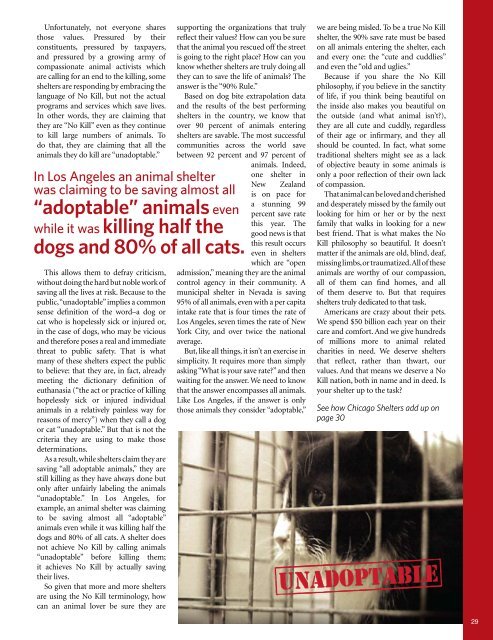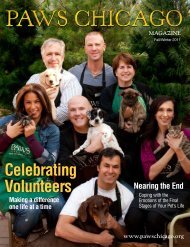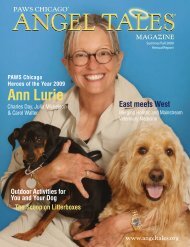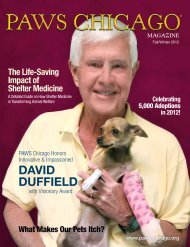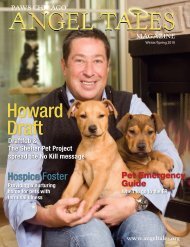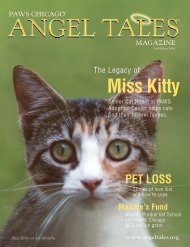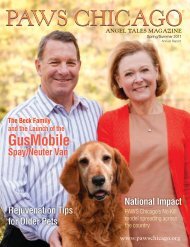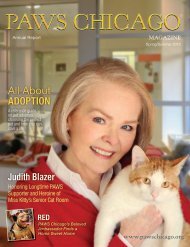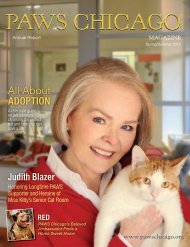Winter 2010 - PAWS Chicago
Winter 2010 - PAWS Chicago
Winter 2010 - PAWS Chicago
You also want an ePaper? Increase the reach of your titles
YUMPU automatically turns print PDFs into web optimized ePapers that Google loves.
Unfortunately, not everyone shares<br />
those values. Pressured by their<br />
constituents, pressured by taxpayers,<br />
and pressured by a growing army of<br />
compassionate animal activists which<br />
are calling for an end to the killing, some<br />
shelters are responding by embracing the<br />
language of No Kill, but not the actual<br />
programs and services which save lives.<br />
In other words, they are claiming that<br />
they are “No Kill” even as they continue<br />
to kill large numbers of animals. To<br />
do that, they are claiming that all the<br />
animals they do kill are “unadoptable.”<br />
This allows them to defray criticism,<br />
without doing the hard but noble work of<br />
saving all the lives at risk. Because to the<br />
public, “unadoptable” implies a common<br />
sense definition of the word–a dog or<br />
cat who is hopelessly sick or injured or,<br />
in the case of dogs, who may be vicious<br />
and therefore poses a real and immediate<br />
threat to public safety. That is what<br />
many of these shelters expect the public<br />
to believe: that they are, in fact, already<br />
meeting the dictionary definition of<br />
euthanasia (“the act or practice of killing<br />
hopelessly sick or injured individual<br />
animals in a relatively painless way for<br />
reasons of mercy”) when they call a dog<br />
or cat “unadoptable.” But that is not the<br />
criteria they are using to make those<br />
determinations.<br />
As a result, while shelters claim they are<br />
saving “all adoptable animals,” they are<br />
still killing as they have always done but<br />
only after unfairly labeling the animals<br />
“unadoptable.” In Los Angeles, for<br />
example, an animal shelter was claiming<br />
to be saving almost all “adoptable”<br />
animals even while it was killing half the<br />
dogs and 80% of all cats. A shelter does<br />
not achieve No Kill by calling animals<br />
“unadoptable” before killing them;<br />
it achieves No Kill by actually saving<br />
their lives.<br />
So given that more and more shelters<br />
are using the No Kill terminology, how<br />
can an animal lover be sure they are<br />
supporting the organizations that truly<br />
reflect their values How can you be sure<br />
that the animal you rescued off the street<br />
is going to the right place How can you<br />
know whether shelters are truly doing all<br />
they can to save the life of animals The<br />
answer is the “90% Rule.”<br />
Based on dog bite extrapolation data<br />
and the results of the best performing<br />
shelters in the country, we know that<br />
over 90 percent of animals entering<br />
shelters are savable. The most successful<br />
communities across the world save<br />
between 92 percent and 97 percent of<br />
animals. Indeed,<br />
one shelter in<br />
In Los Angeles an animal shelter<br />
was claiming to be saving almost all<br />
“adoptable” animals even<br />
while it was killing half the<br />
dogs and 80% of all cats.<br />
New Zealand<br />
is on pace for<br />
a stunning 99<br />
percent save rate<br />
this year. The<br />
good news is that<br />
this result occurs<br />
even in shelters<br />
which are “open<br />
admission,” meaning they are the animal<br />
control agency in their community. A<br />
municipal shelter in Nevada is saving<br />
95% of all animals, even with a per capita<br />
intake rate that is four times the rate of<br />
Los Angeles, seven times the rate of New<br />
York City, and over twice the national<br />
average.<br />
But, like all things, it isn’t an exercise in<br />
simplicity. It requires more than simply<br />
asking “What is your save rate” and then<br />
waiting for the answer. We need to know<br />
that the answer encompasses all animals.<br />
Like Los Angeles, if the answer is only<br />
those animals they consider “adoptable,”<br />
we are being misled. To be a true No Kill<br />
shelter, the 90% save rate must be based<br />
on all animals entering the shelter, each<br />
and every one: the “cute and cuddlies”<br />
and even the “old and uglies.”<br />
Because if you share the No Kill<br />
philosophy, if you believe in the sanctity<br />
of life, if you think being beautiful on<br />
the inside also makes you beautiful on<br />
the outside (and what animal isn’t),<br />
they are all cute and cuddly, regardless<br />
of their age or infirmary, and they all<br />
should be counted. In fact, what some<br />
traditional shelters might see as a lack<br />
of objective beauty in some animals is<br />
only a poor reflection of their own lack<br />
of compassion.<br />
That animal can be loved and cherished<br />
and desperately missed by the family out<br />
looking for him or her or by the next<br />
family that walks in looking for a new<br />
best friend. That is what makes the No<br />
Kill philosophy so beautiful. It doesn’t<br />
matter if the animals are old, blind, deaf,<br />
missing limbs, or traumatized. All of these<br />
animals are worthy of our compassion,<br />
all of them can find homes, and all<br />
of them deserve to. But that requires<br />
shelters truly dedicated to that task.<br />
Americans are crazy about their pets.<br />
We spend $50 billion each year on their<br />
care and comfort. And we give hundreds<br />
of millions more to animal related<br />
charities in need. We deserve shelters<br />
that reflect, rather than thwart, our<br />
values. And that means we deserve a No<br />
Kill nation, both in name and in deed. Is<br />
your shelter up to the task<br />
See how <strong>Chicago</strong> Shelters add up on<br />
page 30<br />
29


